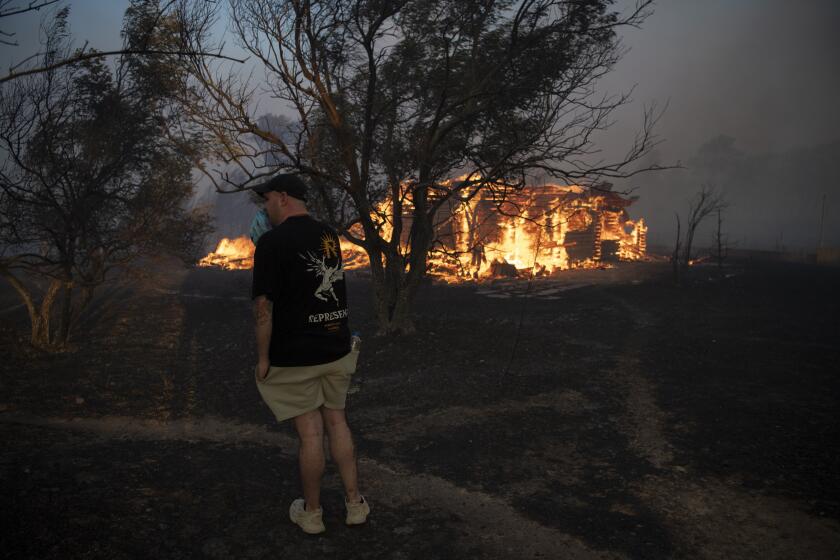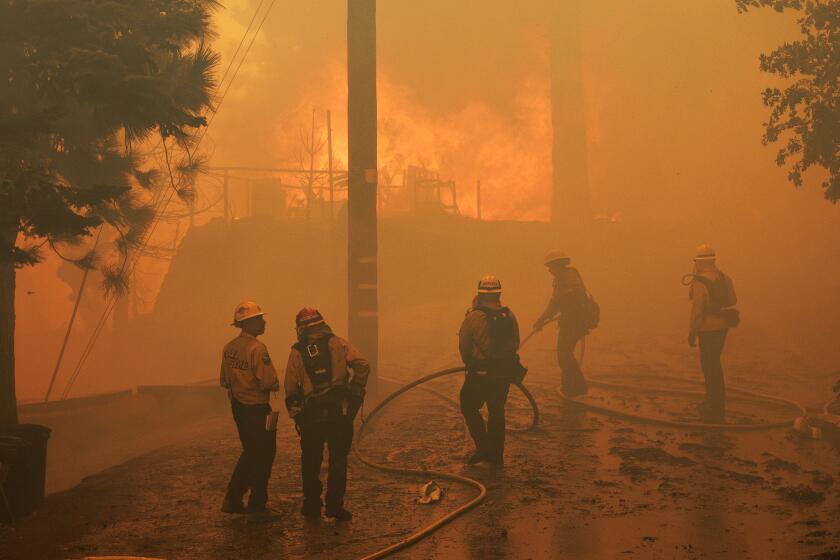Commentary: A terrible decision sparked a wildfire, and the public will pay the price

- Share via
News reports measure wildfires in numbers of acres scorched and structures destroyed. But though the members in my Facebook hiking group hope fervently that no more homes are lost, they also measure the Airport fire in the Santa Ana Mountains by the vistas blackened, oak groves reduced to skeletons, wildlife killed or shoved out to the margins of their habitat, and spectacular, well-loved trails that we won’t be able to set foot on for years.
It’s hard to get official information as the fire rages on, so we’re relying on up-to-date reports from a resident of the area near the fire who has climbed and hiked pretty much every foot of the Cleveland National Forest north of Ortega Highway, and the skills of people who manage to superimpose trail maps onto the official fire maps.
We know Falls Canyon, a short, easy but remote little spot that leads to a 40-foot waterfall, was badly burned, along with the watershed above it that has more waterfalls but is much less accessible to the public. But what about San Juan Trail, with the stunning views of green mountainsides, flowers that are hard to find anywhere else and shade-giving oaks? Or upper Trabuco Canyon, site of old mines and Humboldt lilies, which burned in the Holy fire of 2018?
The suburban sprawl and landscape destruction that helped fuel the fires around Athens apply in Southern California too.
How will an area scorched twice in so few years recover? Local nature wasn’t meant to burn this often. And what will happen to the local mountain lions when they lose so much of their prime, safe territory?
The biggest question of all: Why on earth did Orange County Public Works Department workers think it was a good idea to use heavy equipment to move large boulders in an area of dry brush during an “excessive heat advisory,” which means, among other things, increased risk of wildfire? Steel knocking against rock is a recipe for sparks, even on a normal sunny day. Wouldn’t it at least have been a good idea to have fire-suppression equipment on hand?
The work could have waited. The county was responding to the complaints of nearby residents about noisy off-roaders going into the brush off the dirt road; the boulders were intended to create a barrier.
An overview of evacuation orders, shelter options, mental health resources, donation info and more for the Airport, Bridge and Line fires in Southern California.
The county is reportedly investigating. But considering the damage and the liability involved, this calls for a state probe — and if it finds the county blew it, state fire officials should be issuing commonsense protocols for restricting work that can cause this kind of conflagration. Without objective, outside examination, it’s hard to trust that we’ll ever get a clear answer on where the responsibility lies.
Meanwhile, answers on the damage come slowly. There were reports on Thursday that the fire had hopscotched enough to leave Upper Hot Springs Canyon, with its pretty, terraced waterfall, intact. But then came the news that it was burned. So is the campground that served as its trailhead.
It all comes at a curious time for me. I’m the author of a hiking book that sold out its first two editions, and the publisher has been talking about a third edition. But right now, it looks as though at least seven, maybe eight or nine, of my “50 Hikes in Orange County” are gone — or at least forever changed. California’s wild areas eventually come back after a fire, but now that I am a white-haired wilderness lover, will they return in my hiking lifetime? It’s impossible to accurately describe a trail that might well be transformed in years to come; maybe the time for describing these beautiful areas is over for now.
Orange County has more than 3 million people, and viewed on a map, it’s hard to imagine how they squeeze into such a tiny chunk of land. There are regional wilderness parks, but for the most part, the only way to escape civilization has been to head to the national forest, where the Santa Ana Mountains and tall chaparral provide a visual shield from housing tracts and mini-malls.
Climate change has already been doing a job on many of California’s wild areas; this time, it looks like a county work crew that is supposed to be serving the public, not endangering it, teamed up with a warming planet to deprive a metropolitan area of its best access to nature.
More to Read
A cure for the common opinion
Get thought-provoking perspectives with our weekly newsletter.
You may occasionally receive promotional content from the Los Angeles Times.











